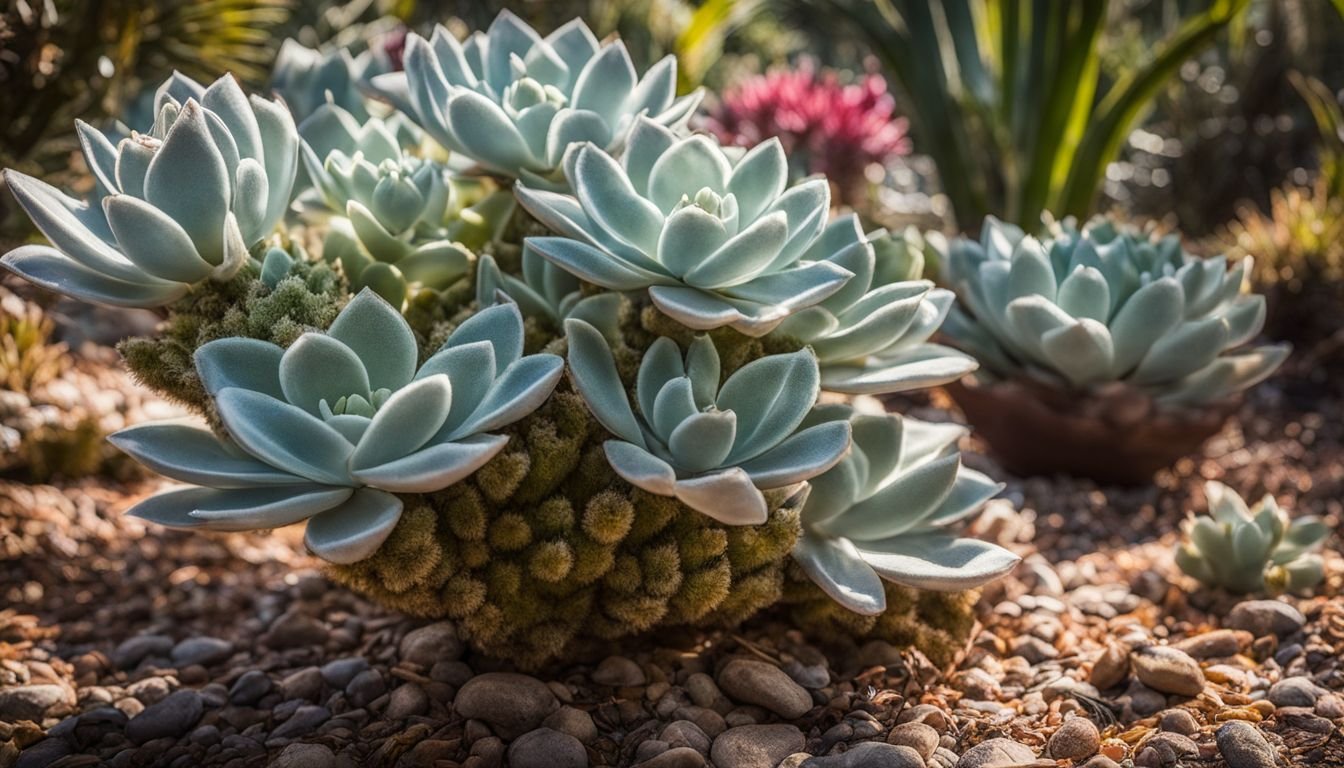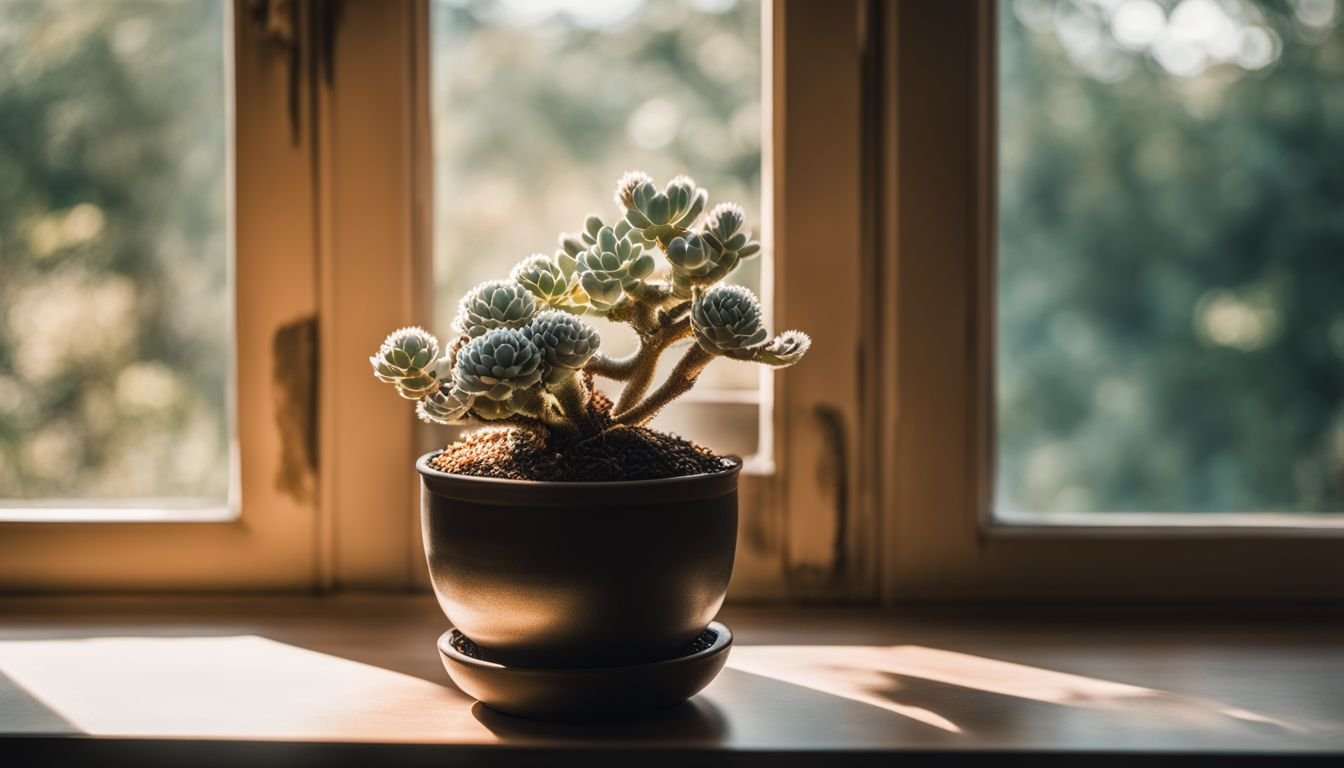Struggling to inject a bit of green into your life amidst Australia’s tough conditions? You’re definitely not in this alone. Many of us dream of a lush garden or a lively indoor plant nook but reckon with the climate we’ve got, it seems like a bit of an ask.
Interestingly though, there’s hope with Pachyphytum oviferum – or as you might know them, “moonstones”. These hardy succulents are just the ticket for well-draining soil and enjoy a good amount of sunshine, making them spot-on for Aussie gardens.
We’ve gone ahead and done the legwork on how to keep these unique beauties thriving in our varied Australian climates. Whether you’re planning on giving them pride of place outside in the sun or keen to spruce up indoors with their quirky charm, this guide’s got you covered.
Prepare yourself for a thriving patch of green that’ll be the envy around. Stick around; what you discover might just tick all the boxes.
Key Takeaways
- Pachyphytum Oviferum, known as moonstones, thrives in full sunlight and requires a well – draining soil mix to avoid root rot. Ensure they get plenty of direct light daily and choose or prepare the right type of soil that allows water to flow through quickly.
- Watering needs attention; only provide moisture when the top layer of soil feels dry to prevent overwatering issues like root rot. Feed them with a balanced liquid nutrient solution once monthly during spring and summer, but reduce feeding in autumn and stop in winter.
- Regularly inspect your moonstones for pests such as mealybugs. Using natural remedies like neem oil can protect them without harming the environment. If any part gets infected, cut it off immediately with sterilised tools to stop further spread.
- Propagating Pachyphytum Oviferum is rewarding. Use healthy leaves or offsets, let cut parts callous before planting on well-draining soil, and ensure they have bright but indirect light until roots form. Repotting should be into slightly larger pots with proper drainage to encourage growth.
- Good air circulation around plants prevents pest infestations whilst avoiding stagnant air around their space enhances overall plant health keeping diseases at bay.
Ideal Conditions for Pachyphytum Oviferum in Australia

To help Pachyphytum Oviferum thrive in Australia, they need lots of sunlight and the right kind of soil. Make sure they get plenty of direct light every day and use a well-draining potting mix to keep them happy.
Full Sun Exposure
Pachyphytum Oviferum loves the sun, and in Australia, we’re lucky to have plenty of it. This plant needs full sunlight all year round to grow strong and healthy. It’s part of the Crassulaceae family, which means it’s built to handle sunny conditions well.
We need to ensure they get enough light every day. If you’ve got a garden or a balcony that catches the sun for most of the day, that’s where your Pachyphytum Oviferum should live.
Giving these plants enough sunlight is key to their care—think about placing them in spots where they’ll soak up those rays without any shadow casting over them. In Australian climates, this usually means an outdoor setting is perfect.
Yet, if you’re growing them indoors or in shadier areas, consider using artificial lights designed for plants. These special lights can mimic natural sunlight and help your succulents thrive even without direct exposure.
“Sunlight is the best remedy for nurturing Pachyphytum Oviferum.”
Ensuring our Pachyphytum Oviferums bathe in adequate sunshine directly impacts how stunning they look and helps avoid common issues like etiolation—where plants stretch out due to lack of light—and color loss.
So let’s take advantage of our bright Australian weather by giving these unique succulents all the sunbathed love they deserve!
Well-draining Soil
We all know that our beloved moonstones need the right type of earth to call home, especially in Australian weather. Choosing well-draining soil isn’t just an option; it’s a must to keep them happy and healthy.
This kind of soil ensures water flows through quickly, preventing moisture from sitting too long around the roots. Root rot is a real worry for these plants, but the right soil mix can protect them.
For those planting in containers, picking a cactus or succulent blend works wonders. These pre-mixed soils have the perfect balance for drainage and nutrition, making your gardening tasks simpler.
If you’re mixing your own, aim for a combination with plenty of perlite or sand to increase airflow and let excess water escape.
Soil preparation sets the stage for everything that follows in gardening. Next up, we dive into how watering and feeding play pivotal roles in nurturing Pachyphytum Oviferum indoors and outside.
Caring for Pachyphytum Oviferum in Indoor and Outdoor Settings

Taking care of Pachyphytum Oviferum, whether inside your home or in the garden, requires attention to a few key practices. For indoor plants, make sure they get plenty of daylight by placing them near windows where sunlight streams in.
Outdoors, choose spots that mimic their natural habitat for optimal growth.
Watering and Feeding Requirements
Caring for Pachyphytum Oviferum means giving it the right amount of water and food. We have to be careful to not overdo it or leave it wanting.
- Water your Pachyphytum Oviferum only when the top soil feels dry. This stops root rot.
- Use your finger to check if the earth is dry down to about 4 inches before watering indoor plants.
- Mix compost with sand or small volcanic rocks for planting. This mix shields the roots.
- For indoor plants, place small stones at the bottom of the container before adding a succulent potting blend on top.
- Feed your plant a balanced liquid nutrient solution during spring and summer once monthly.
- Cut back on feeding in autumn and stop altogether in winter as growth slows down.
By sticking to these guidelines, we ensure our Pachyphytum Oviferum thrives without getting waterlogged or starved of nutrients.
Managing Pests and Diseases
We all know that growing Pachyphytum Oviferum, or Moonstones, involves keeping them healthy and free from pests like mealy bugs. Here’s how you can manage these unwelcome guests and diseases in your Moonstones.
- Inspect your plants regularly. Look closely at the leaves and stems for any signs of pests or unusual spots. Early detection makes treatment more effective.
- Use neem oil as a preventive measure. This natural oil wards off many pests without harming your plant or the environment.
- Remove infected parts immediately. If you see parts of your plant are already affected, cut them off with sterilised secateurs to prevent the spread.
- For mealy bugs, apply alcohol gently with a cotton swab directly on them. The alcohol dries out these pests without damaging the plant.
- Ensure good air circulation around your plants. Pests thrive in stagnant air, so keeping the air moving helps prevent infestations.
- Avoid overwatering as it can lead to root rot and make plants more susceptible to disease.
Now, let’s move on to propagation and repotting techniques to further enhance our gardening skills with Pachyphytum Oviferum.
Propagation and Repotting of Pachyphytum Oviferum
Growing and caring for Pachyphytum Oviferum brings us joy and adds beauty to our gardens. Let’s dive into how we can spread this joy by propagating and giving these plants a fresh home.
- Choose healthy mother plants or leaves for propagation. Look for parts of the plant that show no signs of disease or damage. This ensures a strong start for new growth.
- Gently twist off a leaf or cut an offset with a clean, sharp blade. Make sure you get a clean cut without tearing the plant tissue. This helps in faster healing and rooting.
- Allow the cut part to dry for a few days until it forms a callous. This step is crucial as it prevents rot once the piece is planted.
- Place the dried leaf or offset on top of well – draining soil in a shallow container. The soil should be loose and rich in nutrients to support growth.
- Water sparingly at first, only moistening the top layer of soil when it feels dry to touch. Overwatering can lead to root rot, which is detrimental to young plants.
- Provide bright, indirect light during this stage of growth. Too much direct sunlight might harm delicate young plants still forming roots.
- Wait for roots and new shoots to appear, which shows successful propagation has occurred. This process may take several weeks, so patience is key.
- For repotting, select pots that are slightly larger than the current one but ensure they have good drainage holes at the bottom.
- Prepare a well – draining potting mix suitable for succulents and cacti to fill the new pots.
- It’s time to transfer your Pachyphytum Oviferum carefully into its new pot without damaging its roots.
- Water your newly potted plant sparingly to help the roots adjust without overwhelming them with moisture.
By following these steps, we provide our Pachyphytum Oviferum with everything they need to thrive in their new environment or as freshly propagated plants starting their journey in Australian gardens.
Conclusion and Final Tips for Successful Cultivation
Caring for Pachyphytum Oviferum, or “moonstones,” makes your garden shine. These plants need sun and well-draining dirt to grow well. Remember to water them just right; too much can harm them.
Keep an eye out for mealy bugs but don’t worry, you can easily get rid of these pests. With these tips, your moonstones will thrive, adding beauty and interest to your Australian home garden or indoor space.
FAQs
1. Can Pachyphytum Oviferum grow well in Australian climates?
Yes, Pachyphytum Oviferum thrives in Australian climates, especially in hardiness zone 10a where it enjoys the warm weather.
2. How often should I water my Pachyphytum Oviferum?
Water your plant sparingly; it prefers dry conditions and too much water can harm it. Wait until the soil is completely dry before watering again.
3. Does Pachyphytum Oviferum need special soil to grow?
Yes, this plant does best in well-draining soil to prevent root rot. Consider mixing perlite or sand into your potting mix for better drainage.
4. How much sunlight does a Pachyphytum Oviferum need?
Pachyphytum Oviferums love sunlight! Place them in a spot where they can get at least six hours of direct sunlight every day for optimal growth.
5. What should I do if my Pachyphytum Oviferums leaves start to drop?
Leaf drop can be a sign of overwatering or not enough light. Make sure you’re not watering too frequently and that your plant gets plenty of sunlight.
6. Can I propagate Pachyphytum Oviferums from leaf cuttings?
Absolutely! Just gently twist a leaf from the stem and let it callous over for a few days before placing it on top of moist soil. With patience, new growth will appear.
